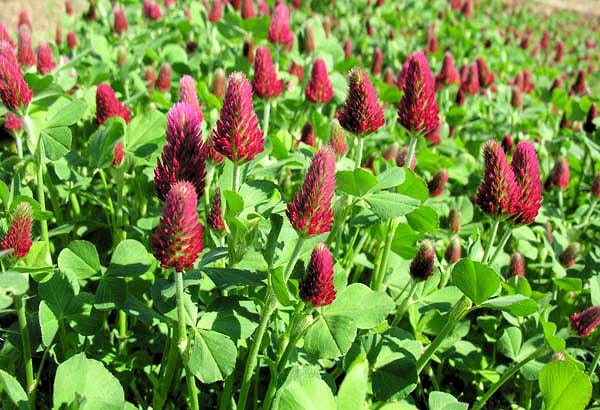September 16, 2013

Everything old is new again aptly describes the renewed interest in cover crops. “Though they have been grown for generations, cover crops are among today’s exciting frontiers in conservation,” reads the first sentence of the 2012-2013 Cover Crop Survey.
The Midwest Cover Crops Council mccc.msu.edu defines cover crops as “plants seeded into agricultural fields, either within or outside of the regular growing season, with the primary purpose of improving or maintaining ecosystem quality.”
Cover crop adoption has been growing rapidly over the last five years, with between 1.5 million to two million acres planted in 2012, report the Conservation Technology Information Center and the North Central Region of Sustainable Agriculture Research & Education. Their most recent survey provided insights about cover crops from more than 750 farmers in 35 states. In fact, Chart 1 lists the benefits they associate most with cover crops.
After last year, the ability of cover crops to help corn and soybeans produce respectable yields despite prolonged drought could be added to the list. In fall 2012, corn planted after cover crops yielded 9.6 percent better than fields with no cover crops, and soybean yields averaged 11.6 percent better following cover crops, according to survey results.
Rob Myers, University of Missouri agronomist and regional director of extension programs for the North Central Region SARE, said that the yield improvements likely resulted from a combination of factors, such as better rooting of the cash crop along with the residue blanket provided by the cover crop (thus reducing soil moisture loss). “Where cover crops have been used for several years, we also know that organic matter typically increases, which improves rainfall infiltration and soil water holding capacity,” he noted.
What do these farmers use? The most popular cover crops among the respondents (who were allowed to give multiple answers) were winter cereal grains (planted by 72 percent of the farmers), followed by brassicas (62 percent), legumes (58 percent) and annual grasses (56 percent).
Two-species and multi-species mixes were moderately popular among respondents. Many cover crop experts recommend mixes of grasses, legumes and brassicas. If a grower plans to plant corn in the spring, for example, Jeremiah Wiese, an independent seed dealer for Merschman Seeds(www.merschmanseeds.com), West Point, IA, recommends a mix from Top Choice, a brand of cover crops developed by Mountain View Seeds, Salem, OR. Top Choice Champion Corn is a mix of annual ryegrass (60 percent), Daikon radish (15 percent) and crimson clover (25 percent). The annual ryegrass develops a large root mass and acts as a nutrient scavenger while the radish develops a deep, soil penetrating tap root that reduces compaction as well as scavenges nutrients. Meanwhile, the crimson clover fixes nitrogen.
When soybeans follow the cover crop, Wiese recommends a mix of 80 percent annual ryegrass and 20 percent of the radish.
The decision about which blend or type of cover crop to plant depends mainly on the grain crop a farmer wants to grow, says Aaron Kuenzi, vice president, marketing manager, Mountain View Seeds - mountainviewseeds.com. The accompanying Selection Guide, developed by Mountain View Seeds, can help farmers determine the types of cover crop species to use in corn, soybean or small grain rotations.
Blending species that scavenge with another species that fixes nitrogen works best, he says. “These species feed off of each other. Planting radish or ryegrass with crimson clover allows them to benefit from some of the nitrogen fixation done by the crimson.”
Green Cover Seed, Bladen, NE, also recommends a mix of cover crop species. The company’s 60 different types of cover crop seed are available in four categories: cool- and warm-season legumes, cool- and warm-season grasses; brassicas (such as radish and turnips), and “other,” the latter which includes broadleaf species, such as sunflower, safflower, buckwheat and flax.
The company has created the accompanying Chart of Mixes that it offers for grazing, spring fallow and other purposes. It also has developed the SmartMix Calculator, which can viewed at greencoverseed.com, that enables users to choose and change seeding rates and watch the calculator analyze mixes for C:N ratio, nitrogen fixation potential, grazing potential, winter tolerance, diversity index and frost tolerance. The calculator figures seeds per pound, seeds per acre, price per pound and the total cost of the mix.
The roots of each plant type exude different chemical compounds, says Keith Berns, co-owner, Green Cover Seed. Radishes, for example, cycle nitrogen and sulfur, the two most mobile nutrients in the soil profile. Meanwhile, buckwheat roots exude an acid that converts phosphorus to a form that plants can use; and safflower and sunflower bring up calcium from the soil.
Challenges
As one might expect, there is no one-size-fits-all mix. This is just one of the challenges involved with growing cover crops, as indicated in Chart 2. Forty-six percent of the farmers responding to the CTIC-SARE survey reported challenges with the establishment of their cover crops followed by time, labor and increased management.
Species selection was the third biggest challenge, followed by the price of seed. Planting/management costs came next, followed by cover crops potentially using too much soil moisture.
In addition, there are some concerns of chemical residue in cover crops. “Growers should be aware of atrazine usage when planting cover crops,” Wiese says, noting that the University of Illinois has published a helpful article, “Be Aware of the Potential for Herbicide Carryover,” on the subject.
Financial assistance
Despite the challenges, the use of cover crops is increasing because of the many environmental benefits. Farmers also may receive some financial assistance to implement cover crop programs through the Natural Resource Conservation Services’s Environmental Quality Incentive Program and Conservation Stewardship Program.
About the Author(s)
You May Also Like




